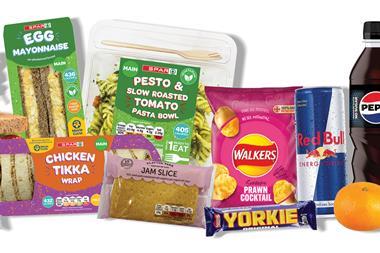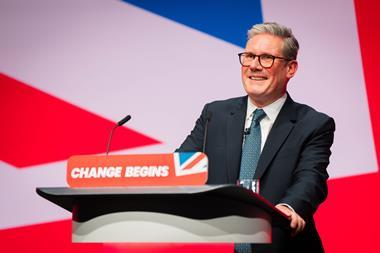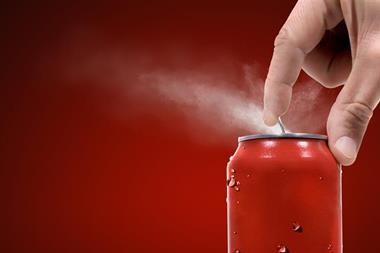Despite the continued growth in popularity of symbol group fascias, many retailers choose to use a family name on their shopfront instead. Sarah Britton finds out why
In a world where big brands mean big business, the number of retailers adopting symbol group fascias is on the increase. However, there is also a band who choose not to follow the herd, and insist on maintaining their own brands above the door.
Nisa member Paul Fisher, who owns Fisher’s of Gerrards Cross, Buckinghamshire, is one such retailer. “Our brand tells people who have never come into the shop that this is not your run-of-the-mill store,” he states. “It’s not a recognised name, so people unfamiliar with the area can drive past it,” he concedes, “but locally we’re well known as we’ve been in Gerrards Cross for so many years.”
Dean Holborn owns two Holborn’s stores in Redhill and South Nutfield, Surrey. He agrees that a well-established family name can go a long way. “We have a family business history of 37 years. About 13 years ago, an independent consultant told me: ‘Protect your name because it’s the biggest thing you’ve got going for you’. It turned out to be good advice.”
Meanwhile, Andy Dike has a Dike & Son logo on the fascia of his large independent supermarket in Stalbridge, Dorset. “Our store name is recognised in this part of the world. My ancestors lived and breathed the business, so the brand represents the continuity of their hard work,” he says. “It’s crucial for us to have our brand above the door. It’s been above a shop in the town since 1851.”
Juliet and Chris Porter started their c-store careers just a few years ago, and so their family name has no long-term associations with retailing. However, they acknowledged that their store in Corfe, Dorset, was already well-known in the area as Clealls, and felt that they would be missing a trick if they changed such a well-respected name.
Jump on the bandwagon
Top tips for making a family-named store a branding success:
Story - The family name needs to have some kind of context within the area so that it is meaningful to your customers
Logo - The logo should be unique and reflective of the brand’s story, either through its typeface, style or imagery
Consistency - In addition to the fascia, the brand should flow throughout the store, be it on shelf- edge labelling or the products themselves
Quality - Everything carrying your brand must be of the same high standard, or you run the risk of diluting the brand.
“The village of Corfe is very traditional and Clealls has been established since 1881 a fact that we highlight in our store logo,” says Juliet. She explains that other stores in the area are unique and quite old fashioned, which appeals to both locals looking for tradition and tourists looking for something quaint yet out of the ordinary.
Symbol relations
Although symbol group fascias are more recognisable to tourists, Julia felt that they wouldn’t work in her particular situation. “Ultimately, it wouldn’t tie in with the village if we went with a symbol group. We did look into joining Spar, Costcutter and Mace, but everything they came up with was very generic.”
Dean had a similar issue when he was considering symbol group offerings. “The general public doesn’t understand how symbols work. Many people can’t get their heads around the fact that you aren’t part of a big company. They don’t realise that symbol group stores are individually owned.”
Nevertheless, while Dean would never dream of removing the Holborn’s fascia, he knows that symbol groups can offer numerous benefits to a retailer. He has a strong relationship with Palmer & Harvey and is currently in talks with the wholesaler about the possibility of incorporating a Mace logo onto part of the fascia, alongside the Holborn’s logo. “We’re really proud of our brand, but I’ve got all the time in the world for symbol groups we run all the Mace promos. For many people coming into the independent sector now, a symbol fascia is their best option because they don’t already have an established brand.”
Andy has also decided that co-branding with a symbol is the way forward. “We did um and er about whether to add the Nisa logo to our fascia, but we’re proud to be members so we’re happy to fly the flag,” he says. “The financial incentive they offered did help, but it’s a nice, fresh sign and I’ve not had one negative comment about it in the 18 months since we’ve had it.”
But while Dean and Andy are in favour of adding symbol group logos to their fascias, Paul is in the process of removing the Nisa logo from his fascia where it currently plays second fiddle to the Fisher’s logo. Paul added the logo 18 months ago on the basis that he would receive quarterly payments from Nisa. But, as a result, customers became confused and thought that the shop had been sold. Paul told Nisa about his concerns and they developed a new scheme called the Independent Fascia Group, whereby they would give him half the payments if he kept the Nisa roundalls on the shop windows, but removed the logo from his fascia. “The Nisa fascia is not an incentive for people to come into the store in the way that Fisher’s is,” explains Paul.
In-store branding
Once you go down the route of self-branding, a well-established name isn’t enough on its own. “You need to have a professional touch throughout the store,” says Dean. “A friend who is a designer created our logo. It was costly, but it’s been really well received. The logo is designed in the style of a hand-written signature to give it a local grocers feel.” The emblem is also used on carrier bags and bags for life, branded shelf-edge labelling and baskets.
Dike & Son’s trademark has also been chosen with care. “Within our logo, the wheatsheaf symbolises where food began, as well as depicting how the company first started up as a bakery,” says Andy. Cultivating his own brand has allowed Andy the freedom to give his store a very rural feel. “We have to fit in with our countryside location above the pet foods we have an image of a rabbit, and we have a picture of a calf suckling in our baby food section.”
He uses the Dike & Son branding throughout the store. “We have self-branded preserves, popcorn and confectionery ranges. We position them within ‘speciality foods’ and people tend to associate them with premium quality.”
Because he wants his brand to be associated with only the best of the best, he is careful not to over-expose it. “We’re limited as to what we can put our brand on. It has to be speciality products it wouldn’t work on a packet of corn flakes!”
Paul agrees that it is important to reinforce an independent brand in-store. The shop’s deli products and fruit and veg, as well as the delivery van, are all Fisher-branded. In addition, Paul has struck a deal with a number of local producers to include the store’s branding on their labelling. “Chiltern Ridge in Chesham, Buckinghamshire, provides us with apple juice, which is labelled ‘Produced specially for Fisher’s’.” He claims that this helps to create a real sense of the brand and encourages shoppers to trust in the name. “The brand is a promise of the quality we deliver.”
Meanwhile, Juliet has worked with a local brewer who supplies the store with its own brand of beer. The store also stocks Clealls-branded fudge, jam, biscuits, cakes, pickles and chutneys. “Some people like to buy it as a present when they’re on holiday in Corfe, but others buy it because they associate our name with good quality.”
Although the Clealls brand is proving to be a winner for Julia, she states that using a family name isn’t right for everyone. “Self-branding is very much down to the area and the demographics. I have local people and tourists interested in my products, but in other areas people may not appreciate a brand like ours in the same way.”
Dean agrees: “Self-branding success depends on your trading position. It works well in a rural location. Our name is what sets us apart from other stores in the area.”
“It wouldn’t work for everyone,” adds Andy. “But if you’ve got a business that’s well established and you’re part of the community then using your own brand can be beneficial.”




























No comments yet